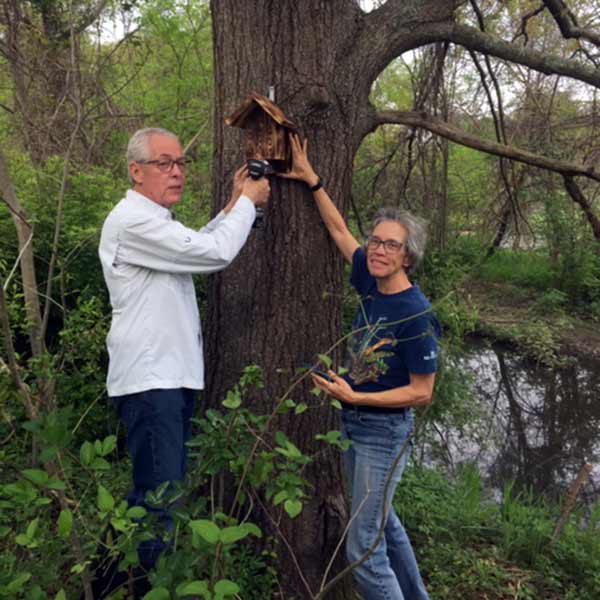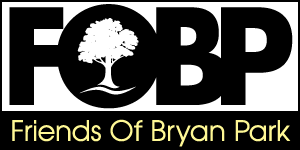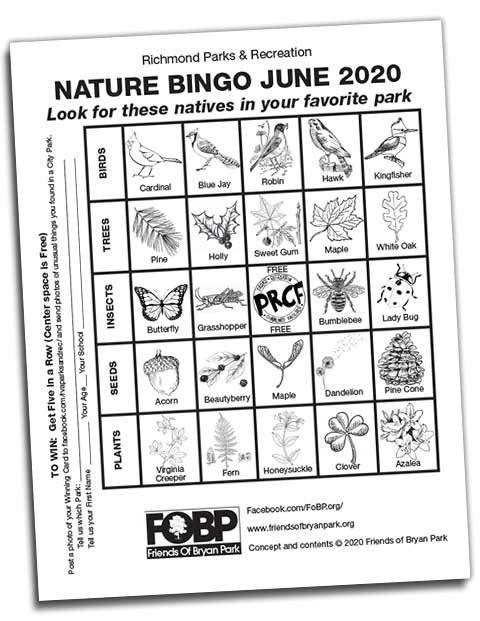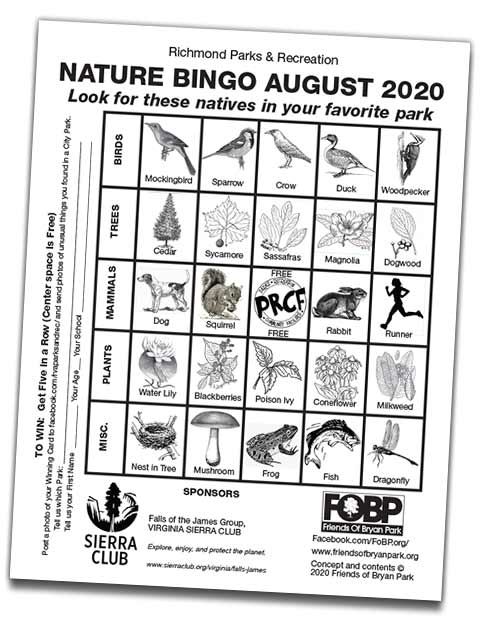bryan park NATURE CENTER, GARDENS, and PARK ENVIRONMENTAL INFORMATION
Bryan Park Nature Center and Educational programs temporary closed! No classes until further notice.
However, Nature Center native Plant and Pollinator Garden and several trails in the Nature Preserve are open and accessible to the public. Follow Park signs to Nature Center (west of Shelter # 1)
Nature Bingo
While the Nature Center is closed, we’ve provided two FUN BINGO GAMES you can download and play in Bryan Park (or any other park in the Richmond area, with your family or friends. Some of the featured creatures are quite common in our parks, and some will challenge you to use your eagle eyes and rabbit ears! Click on the June or August Bingo sheets to print or download.
Get outdoors and have blast!
Courtesy of Friends of Bryan Park and The Falls of the James Group SIERRA CLUB.
Nature Center Native Plant and Pollinator Garden
The Virginia Master Naturalists (Riverine Chapter) has been working for years to create an educational and environmental resource adjacent to the Nature Center. In 6-8 garden plots, they have cultivated typical and unusual native plants, which are labeled clearly; with a concentration on pollinator plants, which are critically important to attract, feed, and host insects and some birds. Most are attracted to showy flowers, filled with sweet nectar or nutritious seeds, and some are attracted to fruit, seed pods or berries. Moths and butterflies are attracted to flower fragrances, and some birds and insects see in the ultraviolet spectrum, so a bland white flower may be lit up with bright glowing purple or hot pink lines that act like landing beacons to the flower’s center. There really IS a secret life of flowering plants and pollinators!
Note that in the vicinity of the Nature Center and in the native plant gardens beside Jordans Branch and Upper Young’s Pond, shrubs and trees have been planted that also attract and sustain a significant number of native birds and insect. In the older trees there, hawks and owls are regular residents – the are sometimes hard to spot but you can hear their distinctive calls. Note too, that many of the damaged trees and the standing trunks of the dead trees are retained, for the homes and shelter they provide, and a delicious source of bugs and grubs.

Virginia Master Naturalist at Upper Pond Bryan Park
The Riverine Chapter of the Virginia Master Naturalists has adopted three important environmental projects in Bryan Park:
- Cultivating the native plants and pollinator gardens.
- Reducing and removing invasive species
- Regularly cleaning Bryan parks floodplains.
The Riverine volunteers generally meet at the Bryan Park Nature Center on Friday mornings, to tend the plants, and water and weed as needed. You are invited to come and meet some of them, and learn first-hand about environmental restoration, the relationship between native plants, insects, and birds, the problems with non-native species and the curse of invasives, and MORE!
For additional information, see the Riverine Chapter of Virginia Master Naturalist website for info about weekly work sessions or special tours, contact by email.

Mason Bee house made by Walt and Jill 2019
Native American Bees and their relatives
Research suggests that European honeybees may out-compete native bees, which would make them lose access to flowers and nectar, diminish their habitat and populations, and push them toward regional extinction. Native bees, such as bumblebees, do not produce much marketable honey, but their role in fertilizing native plants is profound. Did you know that they specialize in fertilizing pumpkins, blueberries and tomatoes?
Friends of Bryan Park and the Riverine volunteers have elected to concentrate on providing Native Bee homes for Bryan Park. You can see them, somewhat like bird-houses, attached to trees, facing east. Feel free to examine them closely, but please do not disturb them.




